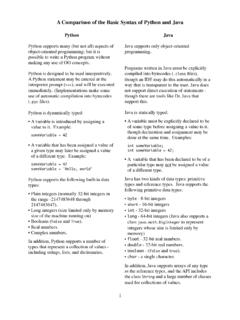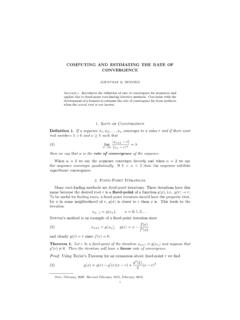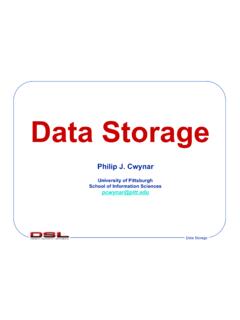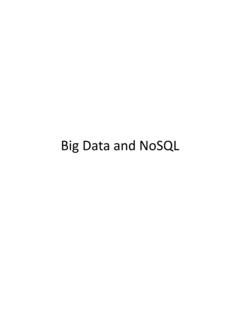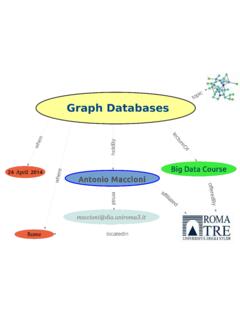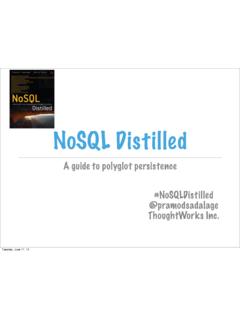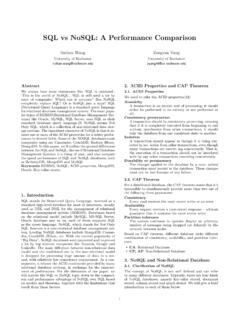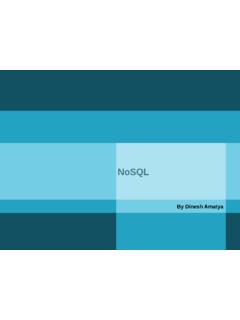Transcription of Database Application Development - Gordon College
1 nosql Databases CPS352: Database Systems Simon Miner Gordon College Last Revised: 4/22/15 Agenda Check-in nosql Databases Aggregate databases Key-value, document, and column family Graph databases Related Topics Distributed Databases and Consistency with nosql Version Stamps Map-Reduce Pattern Schema Migrations Polyglot Persistence When (not) to use nosql Homework 7 Check-in nosql Databases Aggregate Databases: Key-value, Document, Column Family Graph Databases Aggregate Data Models Aggregate a collection of related objects treated as a unit Particularly for data manipulation and consistency management Aggregate-oriented Database a Database comprised of aggregate data structures Supports atomic manipulation of a single aggregate at a time Good for use in clustered storage systems (scaling out)
2 Aggregates make natural units for replication and fragmentation/sharding Aggregates match up nicely with in-memory data structures Use a key or ID to look up an aggregate record An aggregate-ignorant data model has no concept of how its components can aggregate together Good when data will be queried in multiple ways Not so good for clusters Need to minimize data accesses, and including aggregates in the data helps with this Aggregate Database Example: An Initial Relational Model Aggregate Database Example: An Aggregate Data Model Aggregate Database Example: Another Aggregate Model Aggregate-Oriented Databases Key-value databases Stores data that is opaque to the Database The Database cannot see the structure of records, just has a key to access a record Application needs to deal with this Allows flexibility regarding what is stored ( text or binary data) Document databases Stores data whose structure is visible to the Database Imposes limitations on what can be stored Allows more flexible access to data ( partial records)
3 Via querying Both key-value and document databases consist of aggregate records accessed by ID values Column-family databases Two levels of access to aggregates (and hence, two pars to the key to access an aggregate s data) ID to look up aggregate record Column name either a label for a value (name) or a key to a list entry (order id) Columns are grouped into column families Key-Value Databases Key-value store is a simple hash table Records access via key (ID) Akin to a primary key for relational Database records Quickest (or only) way to access a record Values can be of any type -- Database does not care Like blob data type in relational Database Bucket namespace used to segment keys Shows up as (sometimes implicit) prefix or suffix to key Operations Get a value for a given key Set (or overwrite or append)
4 A value for a given key Delete a key and its associated value Key-Value Database Features Consistency only applies in the context of a single key/value pair Need strategy to handle distributed key-value pairs newest write wins, all writes reported and client resolves the conflict No ACID transactions because of performance requirements over distributed cluster Weaker transaction consistency can be asserted by requiring that a certain number of nodes (quorum) get the write Scale by both fragmentation and replication Shard by key values (using a uniform function) Replicas should be available in case a shard fails Otherwise all reads and writes to the unavailable shard fail Interacting with Key-Value Databases Applications can only query by key, not by values in the data Design of key is important Must be unique across the entire Database Bucket can provide an implicit top-level namespace How and what data gets stored is managed entirely at the Application level Single key for related data structures Key incorporates identification data ( user_<sessionID>) Data can include various nested data structures ( user data including session, profile, cart info)
5 All data is set and retrieved at once Different kinds of aggregates all stored in one bucket Increases chance of key conflicts ( profile and session data with same ID) Multiple keys for related data structures Key incorporates name of object being stored ( user_<sessionID>_profile Multiple targeted fetches needed to retrieve related data Decreases chance of key conflicts (aggregates have their own specific namespaces) Expiration times can be assigned to key-value pairs (good for storing transient data) Key-Value Aggregate Examples Using Key-Value Databases Use key-value databases Data accessed via a unique key ( session, user profile, shopping cart, etc.) Transient data Caching Don t use key-value databases Relationships among data Multi-operation transactions Querying by data (value instead of key) Operations on sets of records Document Databases Store of documents with keys to access them Similar to key-value databases Can see and dynamically manipulate the structure of the documents Often structured as JSON (textual) data Each document can have its own structure (non-uniform) Each document is (automatically) assigned an ID value (_id))
6 Consistency and transactions apply to single documents Replication and sharding are by document Queries to documents can be formatted as JSON Able to return partial documents Document Database Example SQL Document Database Query select * from order () select * from order where customerId = 12345 ({ customerId :12345 }) select orderId, orderDate from order where customerId = 12345 ( { customerId :12345}, { orderId :1, orderDate :1} ) select * from order o join orderItem oi on = join product p on = where like %Refactoring% ({ : /Refactoring/ }) // in order collection { customerId :12345, orderId :67890, orderDate: 2012-12-06 , items :[{ product :{ id :112233, name : Refactoring , price : }, discount : 10% }, { product :{ id :223344, name : nosql Distilled , price : }, discount : , promo-code : cybermonday }, ].}
7 } Using Document Databases Use document databases Event logging central store for different kinds of events with various attributes Content management or blogging platforms Web analytics stores E-commerce applications Do not use document databases Transactions across multiple documents (records) Ad hoc cross-document queries Column Family Databases Structure of data records Each record indexed by a key Columns grouped into column families (like RDBMS tables) Additional mechanisms to assist with data management Key space top-level container for a certain kind of data (kind of like a schema in RDBMS) Configuration parameters and operations can apply to a key space number of replicas, data repair operations Columns are specified when a key space is created, but new ones can be added at any time, to only those rows they pertain to Data access Get, set, delete operations Query language ( CQL Cassandra Query Language Column-Family Database Example Column Family Database Example CREATE COLUMNFAMILY Customer ( KEY varchar PRIMARY KEY, name varchar, city varchar, web varchar); INSERT INTO Customer (KEY,name,city,web) VALUES ('mfowler', 'Martin Fowler', 'Boston', ' '); SELECT * FROM Customer.)
8 SELECT name,web FROM Customer WHERE city='Boston Using Column Family Databases Use column family databases Event logging Content management and blogging platforms Counters Expiring data Do not use column family databases Systems requiring ACID transactions Systems requiring ad-hoc aggregate queries Relationships in Aggregate Databases Aggregates contain ID attributes to related aggregates Require multiple Database accesses to traverse relationships One to lookup ID(s) of related aggregate(s) in main aggregate One to retrieve each of the related aggregates Many nosql databases provide mechanisms to make relationships visible to the Database (to make link-walking easier) Updates to relationships require the Application to maintain consistency since atomicity is limited to each aggregate Aggregate databases become awkward when it is necessary to navigate around many aggregates Graph databases small nodes connected by many edges Make navigating complex relationships fast Linking nodes is done at time of insert.
9 And not at query time Data Management Scale with Aggregate Databases Different aggregate data models have differing data management capabilities Key-value databases Opaque data store Almost no Database involvement with managing data Document databases Transparent data store Some facilities in databases to administer data (partial record queries, indexes) Column family databases Transparent data store and dynamic schema Data management constructs (key spaces, query languages) Relational databases Static uniform schema Database manages the data (integrity constraints, security, etc.) Graph Databases Excel at modeling relationships between entities Terminology Node an entity or record in the Database Edge a directed relationship connecting two entities Two nodes can have multiple relationships between them Property attribute on a node or edge Graphs are queried via traversals Traversing multiple nodes and edges is very fast Because relationships are determined when data is inserted into the Database Relationships (edges) are persisted just like nodes Not computed at query time (as in relational databases)
10 Graph Database Example Graph Database Example Graph Database Features Transaction support graph can only be modified within a transaction No dangling relationships allowed Nodes can only be deleted if they have no edges connected to them Availability via replication Scaling via sharding is difficult since the graph relies heavily on the relationships between its nodes Fragmentation can be done using domain knowledge ( separating relationships by different geographic regions, categories, time periods, etc. factors don t get traversed much) Traversal across shards is very expensive Interacting with Graph Databases Web services / REST APIs exposed by the Database Language-specific libraries provided by the Database vendor or community // Find the names of people who like nosql Distilled Node nosqlDistilled = ("name", " nosql Distilled").
